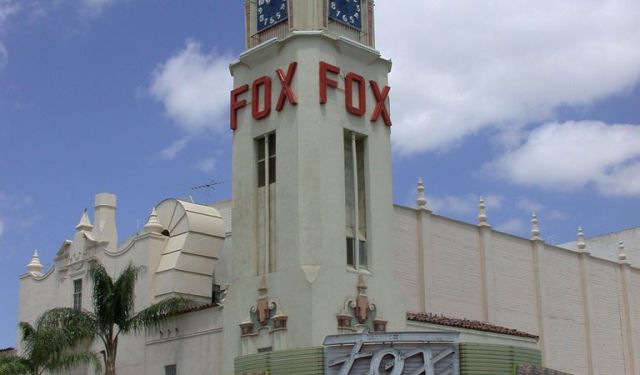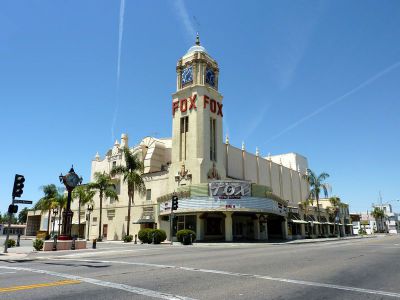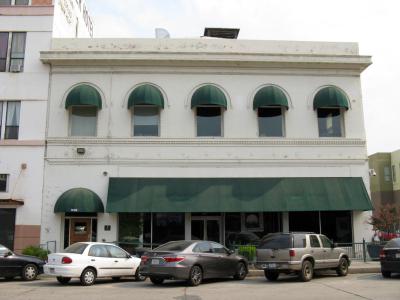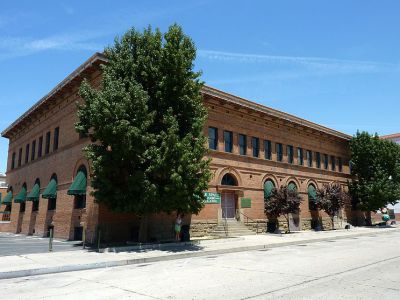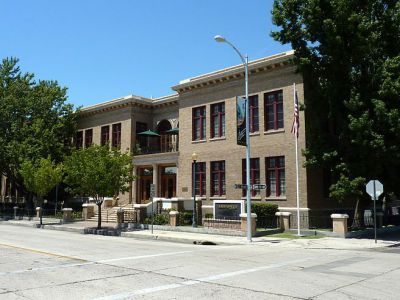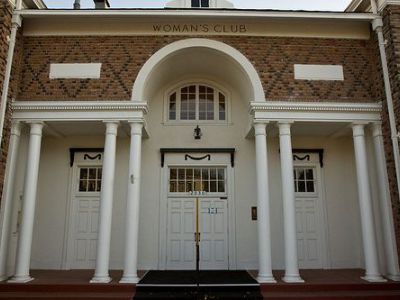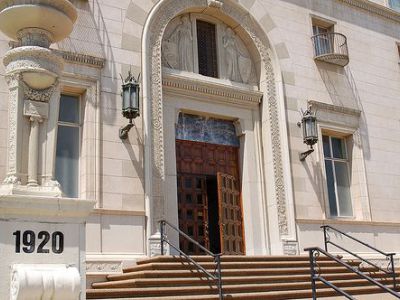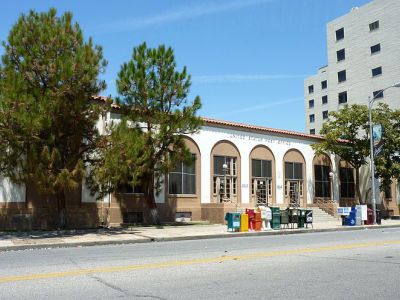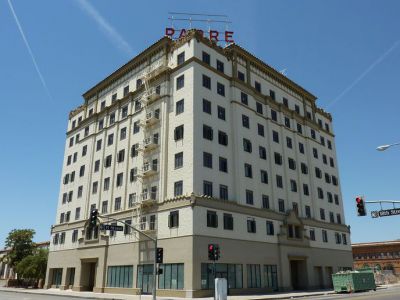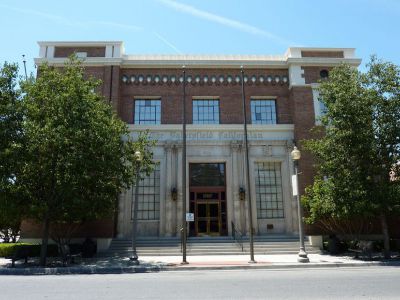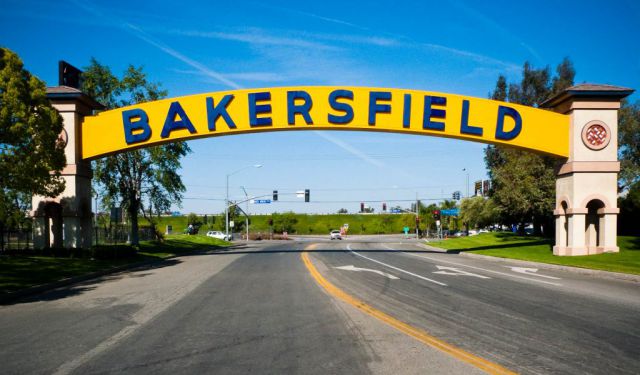Bakersfield Historical Buildings Tour (Self Guided), Bakersfield
Although many buildings in Bakersfield, California were damaged during the earthquake of 1952, the majority of them have survived and since then been carefully restored and preserved. Thanks to this effort, the city boasts a rich tapestry of historical properties reflecting its growth and cultural heritage.
Among these landmarks, the Fox Theater stands out as a beacon of entertainment history. Built in 1930, its Art Deco style and iconic marquee have made it a beloved venue for performances and events over the decades.
The Hayden Building, dating back to the early 1900s, is a prime example of Bakersfield's commercial architecture. Nearby, the Tevis Block and Jastro Building continue this theme, showcasing Bakersfield's turn-of-the-20th-century economic boom.
The Women's Club of Bakersfield, established in 1896, reveals in its building a blend of Victorian and Classical Revival styles and has been a center for community gatherings and charitable activities for over a century.
The Masonic Temple, constructed in 1923, exemplifies Bakersfield's fraternal history and architectural grandeur. Its imposing presence and Masonic symbolism reflect the values and traditions upheld by its members throughout the city's history.
The Post Office Building, erected in 1925, with its Mission architecture and central location, underscores Bakersfield's significance as a regional communication and administration hub.
The Padre Hotel, a Spanish Colonial Revival landmark since 1928, represents Bakersfield's hospitality industry and architectural innovation.
Finally, the Bakersfield Californian Building, home to the city's oldest continuously operating newspaper, embodies Bakersfield's journalistic heritage and commitment to free press.
Whether as venues for entertainment, centers of commerce, or symbols of community spirit, these historical buildings invite viewers to explore and appreciate Bakersfield's vibrant past. Take this tour to discover stories within these walls, walk the streets that echo with history, and experience firsthand the legacy of resilience and creativity that continues to shape this dynamic city.
Among these landmarks, the Fox Theater stands out as a beacon of entertainment history. Built in 1930, its Art Deco style and iconic marquee have made it a beloved venue for performances and events over the decades.
The Hayden Building, dating back to the early 1900s, is a prime example of Bakersfield's commercial architecture. Nearby, the Tevis Block and Jastro Building continue this theme, showcasing Bakersfield's turn-of-the-20th-century economic boom.
The Women's Club of Bakersfield, established in 1896, reveals in its building a blend of Victorian and Classical Revival styles and has been a center for community gatherings and charitable activities for over a century.
The Masonic Temple, constructed in 1923, exemplifies Bakersfield's fraternal history and architectural grandeur. Its imposing presence and Masonic symbolism reflect the values and traditions upheld by its members throughout the city's history.
The Post Office Building, erected in 1925, with its Mission architecture and central location, underscores Bakersfield's significance as a regional communication and administration hub.
The Padre Hotel, a Spanish Colonial Revival landmark since 1928, represents Bakersfield's hospitality industry and architectural innovation.
Finally, the Bakersfield Californian Building, home to the city's oldest continuously operating newspaper, embodies Bakersfield's journalistic heritage and commitment to free press.
Whether as venues for entertainment, centers of commerce, or symbols of community spirit, these historical buildings invite viewers to explore and appreciate Bakersfield's vibrant past. Take this tour to discover stories within these walls, walk the streets that echo with history, and experience firsthand the legacy of resilience and creativity that continues to shape this dynamic city.
How it works: Download the app "GPSmyCity: Walks in 1K+ Cities" from Apple App Store or Google Play Store to your mobile phone or tablet. The app turns your mobile device into a personal tour guide and its built-in GPS navigation functions guide you from one tour stop to next. The app works offline, so no data plan is needed when traveling abroad.
Bakersfield Historical Buildings Tour Map
Guide Name: Bakersfield Historical Buildings Tour
Guide Location: USA » Bakersfield (See other walking tours in Bakersfield)
Guide Type: Self-guided Walking Tour (Sightseeing)
# of Attractions: 9
Tour Duration: 1 Hour(s)
Travel Distance: 1.2 Km or 0.7 Miles
Author: Sandra
Sight(s) Featured in This Guide:
Guide Location: USA » Bakersfield (See other walking tours in Bakersfield)
Guide Type: Self-guided Walking Tour (Sightseeing)
# of Attractions: 9
Tour Duration: 1 Hour(s)
Travel Distance: 1.2 Km or 0.7 Miles
Author: Sandra
Sight(s) Featured in This Guide:
- Fox Theater
- Hayden Building
- Tevis Block
- Jastro Building
- Women's Club
- Masonic Temple
- Post Office Building
- Padre Hotel
- Bakersfield Californian Building
1) Fox Theater (must see)
The Fox Theater has been a central hub for performing arts since it opened on Christmas Day in 1930. Renowned for its architectural charm and cultural significance, the theater has hosted a wide array of performances, from ballets to contemporary pop and rock acts, making it a vibrant fixture in Bakersfield's arts and entertainment scene.
The Fox Theater's inaugural feature was "Just Imagine," a science fiction film set 50 years in the future. The 1930s marked a golden era for the theater, with its screen showcasing the latest "talkie" films and its stage graced by notable performers. These included Metropolitan Opera baritone Lawrence Tibbett, soprano Kirsten Flagstad, the Los Angeles Philharmonic Orchestra, and pianist Arthur Rubinstein. The theater's robust Type I construction, consisting of poured concrete over steel, enabled it to withstand the devastating 1952 earthquake that leveled many buildings in Bakersfield, further cementing its legacy as a resilient and enduring cultural landmark.
Today, the Fox Theater remains the heart of Downtown Bakersfield's arts and entertainment district. It is home to FLICS, Bakersfield's acclaimed foreign film program, which runs annually from fall through spring and features the best foreign films of the past year. The theater continues to attract a variety of music stars, such as Cyndi Lauper, Olivia Newton-John, and Switchfoot, while also hosting local dance recitals and performing arts events, including the Russian ballet. This diverse programming ensures that the Fox Theater remains a beloved venue for both residents and visitors, celebrating the richness of Bakersfield's cultural heritage.
The Fox Theater's inaugural feature was "Just Imagine," a science fiction film set 50 years in the future. The 1930s marked a golden era for the theater, with its screen showcasing the latest "talkie" films and its stage graced by notable performers. These included Metropolitan Opera baritone Lawrence Tibbett, soprano Kirsten Flagstad, the Los Angeles Philharmonic Orchestra, and pianist Arthur Rubinstein. The theater's robust Type I construction, consisting of poured concrete over steel, enabled it to withstand the devastating 1952 earthquake that leveled many buildings in Bakersfield, further cementing its legacy as a resilient and enduring cultural landmark.
Today, the Fox Theater remains the heart of Downtown Bakersfield's arts and entertainment district. It is home to FLICS, Bakersfield's acclaimed foreign film program, which runs annually from fall through spring and features the best foreign films of the past year. The theater continues to attract a variety of music stars, such as Cyndi Lauper, Olivia Newton-John, and Switchfoot, while also hosting local dance recitals and performing arts events, including the Russian ballet. This diverse programming ensures that the Fox Theater remains a beloved venue for both residents and visitors, celebrating the richness of Bakersfield's cultural heritage.
2) Hayden Building
The Hayden Building is a classic example of the Second Renaissance Revival architectural style. Designed by San Francisco architect Charles I. Haven, the building was completed in 1904 for the Kern County Land Company and initially housed the Hayden Furniture Company. Over the years, this historic structure has served a diverse array of tenants, reflecting its adaptability and the changing needs of the community.
Following its original use, the building became home to the Ancient Order of United Workmen and then transitioned to Mrs. Andrews' Dancing Hall for children. It later hosted the Continental Hotel and the Valley Office Supply Company, each adding to the building's rich history. In 1991, Curtis and Peggy Darling acquired the Hayden Building, transforming it into an office space and establishing KBID Radio on the second floor, further embedding the structure into Bakersfield's cultural fabric.
In 1998, the building took on a new role as the Spotlight Theatre and Cafe, occupying the basement, ground floor, and mezzanine. This venue became a vibrant space for contemporary playwrights and composers, highlighting the building's continuous evolution and its importance as a cultural and historical landmark in Bakersfield.
Following its original use, the building became home to the Ancient Order of United Workmen and then transitioned to Mrs. Andrews' Dancing Hall for children. It later hosted the Continental Hotel and the Valley Office Supply Company, each adding to the building's rich history. In 1991, Curtis and Peggy Darling acquired the Hayden Building, transforming it into an office space and establishing KBID Radio on the second floor, further embedding the structure into Bakersfield's cultural fabric.
In 1998, the building took on a new role as the Spotlight Theatre and Cafe, occupying the basement, ground floor, and mezzanine. This venue became a vibrant space for contemporary playwrights and composers, highlighting the building's continuous evolution and its importance as a cultural and historical landmark in Bakersfield.
3) Tevis Block
The Tevis Block, also recognized as the Kern County Land Company Building, stands as a testament to Bakersfield's rich architectural heritage in California. This historic office building, listed on the National Register of Historic Places since March 29, 1984, exudes charm and character that harkens back to a bygone era.
Constructed as a two-story, U-shaped structure using imported fire brick, the Tevis Block boasts a distinctive design that sets it apart. Its front facade, facing south, showcases elegant fanlight windows and terra cotta arches, adding a touch of sophistication to its appearance. Notably, each floor of the building is characterized by unique articulation, featuring different orders and finishes that contribute to its visual appeal.
The architectural details of the Tevis Block are a testament to the craftsmanship of the past. From the meticulously designed basement windows to the intricate brickwork enhancing the first-floor windows, every element speaks to the building's storied history. Additionally, later additions such as the enclosed elevator at the rear and the one-story brick wing further add to the building's architectural significance, showcasing its evolution over time.
Constructed as a two-story, U-shaped structure using imported fire brick, the Tevis Block boasts a distinctive design that sets it apart. Its front facade, facing south, showcases elegant fanlight windows and terra cotta arches, adding a touch of sophistication to its appearance. Notably, each floor of the building is characterized by unique articulation, featuring different orders and finishes that contribute to its visual appeal.
The architectural details of the Tevis Block are a testament to the craftsmanship of the past. From the meticulously designed basement windows to the intricate brickwork enhancing the first-floor windows, every element speaks to the building's storied history. Additionally, later additions such as the enclosed elevator at the rear and the one-story brick wing further add to the building's architectural significance, showcasing its evolution over time.
4) Jastro Building
The Jastro Building, also referred to as the Standard Oil Building, stands as a prominent landmark in downtown Bakersfield, California, boasting a rich history and architectural significance. Recognized for its historical and architectural value, the structure was listed on the National Register of Historic Places on September 22, 1983, cementing its status as an integral part of Bakersfield's heritage.
Constructed in the late-Second Renaissance Revival style, the Jastro Building is a two-story edifice that exudes timeless elegance and charm. Its construction occurred in two phases, with the initial section completed in 1917 and a subsequent addition in 1921, which expanded the building with a 10,000 square feet wing. The architectural design showcases meticulous attention to detail, with a "C" shape layout for the first floor and an "H" shape configuration for the second floor, lending a sense of grandeur to the structure.
One of the defining features of the Jastro Building is its thoughtfully designed facade, characterized by vertical, 2-sash casement windows with transom, and a distinctive indented porch over the front facade. The main entrance, located on the first floor beneath the porch, serves as a focal point, welcoming visitors with its timeless appeal. Additionally, the building's flat roof with boxed cornice bracketed parapet adds to its architectural allure, while the molded arches with frieze on the second-story center porch windows contribute to its visual interest.
Constructed in the late-Second Renaissance Revival style, the Jastro Building is a two-story edifice that exudes timeless elegance and charm. Its construction occurred in two phases, with the initial section completed in 1917 and a subsequent addition in 1921, which expanded the building with a 10,000 square feet wing. The architectural design showcases meticulous attention to detail, with a "C" shape layout for the first floor and an "H" shape configuration for the second floor, lending a sense of grandeur to the structure.
One of the defining features of the Jastro Building is its thoughtfully designed facade, characterized by vertical, 2-sash casement windows with transom, and a distinctive indented porch over the front facade. The main entrance, located on the first floor beneath the porch, serves as a focal point, welcoming visitors with its timeless appeal. Additionally, the building's flat roof with boxed cornice bracketed parapet adds to its architectural allure, while the molded arches with frieze on the second-story center porch windows contribute to its visual interest.
5) Women's Club
Constructed in 1921, the Women's Club - an elegant and meticulously adorned building - was designed by architect Charles Howatt Biggar in the distinguished Colonial Revival style, exuding timeless sophistication and charm.
The Women's Club boasts a striking embayed portico entrance adorned with majestic Ionic columns, which serve as a grand welcome to visitors and passersby alike. Against the backdrop of the main structure's red brick facade, the white cornices add a touch of contrast and elegance, enhancing the building's visual appeal. Since its inception in 1896, the Women's Club has played a pivotal role in fostering a sense of community and empowerment among women, promoting participation in literature, art, and the sciences.
Despite undergoing minor alterations following the 1952 earthquake, the Women's Club remains a cherished historical and architectural landmark in Bakersfield.
The Women's Club boasts a striking embayed portico entrance adorned with majestic Ionic columns, which serve as a grand welcome to visitors and passersby alike. Against the backdrop of the main structure's red brick facade, the white cornices add a touch of contrast and elegance, enhancing the building's visual appeal. Since its inception in 1896, the Women's Club has played a pivotal role in fostering a sense of community and empowerment among women, promoting participation in literature, art, and the sciences.
Despite undergoing minor alterations following the 1952 earthquake, the Women's Club remains a cherished historical and architectural landmark in Bakersfield.
6) Masonic Temple
The Masonic Temple is a significant landmark with deep historical roots dating back to the establishment of the local Freemasons chapter in 1862. The Temple was constructed in 1923 by Carl Werner, embodying the grandeur and elegance of the Renaissance Revival style. This architectural gem reflects the rich heritage and enduring presence of the Freemasons in Bakersfield.
The Masonic Building is distinguished by its imposing rooms and stately design, making it a prominent fixture in the city. The structure includes an impressive auditorium, often utilized for various gatherings and events, which showcases the building's versatility and grandeur. Additionally, a well-appointed conference room is available for rent, providing a distinguished setting for special occasions, meetings, and community events.
Beyond its architectural significance, the Masonic Temple serves as a testament to the Freemasons' long-standing contribution to the social and cultural fabric of Bakersfield. The building not only represents the historical significance of the Freemasons but also continues to be a vibrant part of the community, hosting events and fostering a sense of fellowship.
Today, the Masonic Building stands as a symbol of historical preservation and community engagement. Its Renaissance Revival architecture, coupled with its multifaceted use, makes it a cherished landmark in Bakersfield, reflecting both the city's historical journey and its ongoing community spirit.
The Masonic Building is distinguished by its imposing rooms and stately design, making it a prominent fixture in the city. The structure includes an impressive auditorium, often utilized for various gatherings and events, which showcases the building's versatility and grandeur. Additionally, a well-appointed conference room is available for rent, providing a distinguished setting for special occasions, meetings, and community events.
Beyond its architectural significance, the Masonic Temple serves as a testament to the Freemasons' long-standing contribution to the social and cultural fabric of Bakersfield. The building not only represents the historical significance of the Freemasons but also continues to be a vibrant part of the community, hosting events and fostering a sense of fellowship.
Today, the Masonic Building stands as a symbol of historical preservation and community engagement. Its Renaissance Revival architecture, coupled with its multifaceted use, makes it a cherished landmark in Bakersfield, reflecting both the city's historical journey and its ongoing community spirit.
7) Post Office Building
Constructed in 1925, the Post Office Building was designed by the prominent American architect James A. Wetmore. Known for his contributions to numerous federal buildings across the United States, Wetmore imbued the Post Office Building with a blend of functionality and subtle elegance.
Built with brick and reinforced concrete, the structure is characterized by its durability and simplicity. One of the building's most distinctive features is its decorative arched embayments, which add a touch of architectural charm to its otherwise straightforward design. These arched embayments are not only aesthetically pleasing but also reflect the architectural trends of the early 20th century, providing a glimpse into the design sensibilities of that era.
For many years, the Post Office Building has served as Bakersfield’s official federal government center, playing a crucial role in the city's administrative and civic life. As a central hub for postal services and federal operations, it has been an essential part of the community, facilitating communication and government functions. Its longstanding presence underscores its importance to the city's infrastructure and daily operations.
Built with brick and reinforced concrete, the structure is characterized by its durability and simplicity. One of the building's most distinctive features is its decorative arched embayments, which add a touch of architectural charm to its otherwise straightforward design. These arched embayments are not only aesthetically pleasing but also reflect the architectural trends of the early 20th century, providing a glimpse into the design sensibilities of that era.
For many years, the Post Office Building has served as Bakersfield’s official federal government center, playing a crucial role in the city's administrative and civic life. As a central hub for postal services and federal operations, it has been an essential part of the community, facilitating communication and government functions. Its longstanding presence underscores its importance to the city's infrastructure and daily operations.
8) Padre Hotel
The Padre Hotel, a historical landmark in Bakersfield, was originally constructed in 1928 during the Central Valley's early and notorious oil rush days. The eight-story hotel, built in the Spanish Colonial Revival style, quickly became a symbol of the region's burgeoning prosperity.
Its history is rich with colorful anecdotes, none more so than those involving Milton “Spartacus” Miller, who purchased the hotel in 1954. Known for his flamboyant and defiant personality, Miller frequently clashed with the city authorities. His most infamous act was mounting a fake missile on the hotel's roof aimed at City Hall, a symbolic gesture of his disdain and rebellious spirit. Miller's influence and eccentricities left an indelible mark on the hotel's legacy until his death in 1999.
The hotel’s history, however, is also marked by tragedy. In the 1950s, a fire on the seventh floor resulted in numerous fatalities, including children. Additionally, the Padre Hotel has been the site of several suicides from its rooftop, adding a somber layer to its storied past. These incidents contributed to a reputation that mingled the grandeur of its early days with the darker tales of human loss and despair.
Following decades of decline, the Padre Hotel fell into significant disrepair from the 1960s onwards. By the time of its most recent renovation in 2010, the upper floors had been condemned, often inhabited by squatters. Despite the dilapidation, the bar on the ground floor remained operational, becoming a notorious meeting spot for the city's misfits and barflies. This period of dereliction further cemented the Padre's place in Bakersfield's urban folklore.
The comprehensive renovation in 2010 marked a new chapter for the Padre Hotel, restoring it to its former glory while preserving its historical essence. Today, the revitalized hotel stands as a testament to Bakersfield's resilience and ability to reinvent itself, blending its rich historical legacy with modern luxury.
Its history is rich with colorful anecdotes, none more so than those involving Milton “Spartacus” Miller, who purchased the hotel in 1954. Known for his flamboyant and defiant personality, Miller frequently clashed with the city authorities. His most infamous act was mounting a fake missile on the hotel's roof aimed at City Hall, a symbolic gesture of his disdain and rebellious spirit. Miller's influence and eccentricities left an indelible mark on the hotel's legacy until his death in 1999.
The hotel’s history, however, is also marked by tragedy. In the 1950s, a fire on the seventh floor resulted in numerous fatalities, including children. Additionally, the Padre Hotel has been the site of several suicides from its rooftop, adding a somber layer to its storied past. These incidents contributed to a reputation that mingled the grandeur of its early days with the darker tales of human loss and despair.
Following decades of decline, the Padre Hotel fell into significant disrepair from the 1960s onwards. By the time of its most recent renovation in 2010, the upper floors had been condemned, often inhabited by squatters. Despite the dilapidation, the bar on the ground floor remained operational, becoming a notorious meeting spot for the city's misfits and barflies. This period of dereliction further cemented the Padre's place in Bakersfield's urban folklore.
The comprehensive renovation in 2010 marked a new chapter for the Padre Hotel, restoring it to its former glory while preserving its historical essence. Today, the revitalized hotel stands as a testament to Bakersfield's resilience and ability to reinvent itself, blending its rich historical legacy with modern luxury.
9) Bakersfield Californian Building
The Bakersfield Californian Building is a historic office building and home to the newspaper, The Bakersfield Californian. It was placed on the National Register of Historic Places on March 10, 1983, recognizing its architectural and historical significance. This building has been a central fixture for the newspaper since its construction, reflecting the growth and development of Bakersfield's media landscape.
The building comprises two main structures faced with distinctive reddish-brown bricks, with the primary facade facing east. The four-story main building was initially rectangular but has since evolved into an L-shaped structure due to various additions over the years. A notable feature is the detached, 900-square-foot rectangular building at the northeast corner, initially designed as a women's rest facility, highlighting the thoughtful architectural planning for the building’s occupants.
Architecturally, the Bakersfield Californian Building is notable for its exterior brick pilasters on the secondary sides, which cover the structural steel, adding both aesthetic appeal and structural integrity. The main entrance on the eastern facade is striking, featuring seven wide granite steps leading to polished brass double glass doors. This entrance is divided into three sections by columns, each with large rectangular openings. The side sections include large multipaned windows with heraldic shields above, one of which bears the architect's name, adding to the building's historical charm. The center section, framed by Corinthian columns, includes the main doors and a multipaned transom, creating a grand and inviting entryway.
The parapet above the entrance is inscribed with "The Bakersfield Californian," a testament to the building's enduring role as the headquarters for the newspaper. A later renovation updated this inscription with a new font, blending modern touches with the building’s historic elements. This blend of old and new encapsulates the building's significance as both a historical landmark and a functional space for contemporary use.
The building comprises two main structures faced with distinctive reddish-brown bricks, with the primary facade facing east. The four-story main building was initially rectangular but has since evolved into an L-shaped structure due to various additions over the years. A notable feature is the detached, 900-square-foot rectangular building at the northeast corner, initially designed as a women's rest facility, highlighting the thoughtful architectural planning for the building’s occupants.
Architecturally, the Bakersfield Californian Building is notable for its exterior brick pilasters on the secondary sides, which cover the structural steel, adding both aesthetic appeal and structural integrity. The main entrance on the eastern facade is striking, featuring seven wide granite steps leading to polished brass double glass doors. This entrance is divided into three sections by columns, each with large rectangular openings. The side sections include large multipaned windows with heraldic shields above, one of which bears the architect's name, adding to the building's historical charm. The center section, framed by Corinthian columns, includes the main doors and a multipaned transom, creating a grand and inviting entryway.
The parapet above the entrance is inscribed with "The Bakersfield Californian," a testament to the building's enduring role as the headquarters for the newspaper. A later renovation updated this inscription with a new font, blending modern touches with the building’s historic elements. This blend of old and new encapsulates the building's significance as both a historical landmark and a functional space for contemporary use.
Walking Tours in Bakersfield, California
Create Your Own Walk in Bakersfield
Creating your own self-guided walk in Bakersfield is easy and fun. Choose the city attractions that you want to see and a walk route map will be created just for you. You can even set your hotel as the start point of the walk.
Bakersfield Introduction Walking Tour
Bakersfield, California is a hub of culture and history tucked away in the southern end of the San Joaquin Valley. Native Americans, specifically the Yokuts people, inhabited present-day Bakersfield for thousands of years. In 1776, Spanish missionary Francisco Garcés was the first European to explore this territory, encountering its indigenous population.
Among those attracted to the area by... view more
Tour Duration: 2 Hour(s)
Travel Distance: 3.1 Km or 1.9 Miles
Among those attracted to the area by... view more
Tour Duration: 2 Hour(s)
Travel Distance: 3.1 Km or 1.9 Miles
The Most Popular Cities
/ view all
